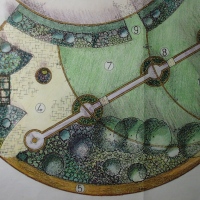A genus of over 350 species, Verbascums are native to Europe, North Africa and Asia. Most of the species are biennial, though there are some annuals, perennials and sub shrubs and a few evergreens.
The perennials are often short-lived, dying after flowering, though they (like all species) are prolific self seeders. Verbascums mostly grow on open scrubland or dry hillsides, though some are found in open woodland. They like a sunny position with sharply drained soil.
Verbascums generally form a basal clump or rosette of leaves, these usually being large, soft and simple in shape, some with lobed or toothed edges. They produce one or a few spikes of flowers- these are densely packed and with saucer-shaped flowers. The flowers are individually short-lived, but are borne successively over along growing season. Flowers on hybrid cultivars are larger and showier.
Many Verbascums (or ‘mulleins’) grow quite tall (up to 3 metres) and need to be staked. Seedlings of named varieties will not grow true to their host, so these should be deadheaded before shedding their seed if you want to avoid a mixture of flower colours. The cultivars ‘Gainsborough’, ‘Letitia‘ and ‘Pink Domino’ have gained the Royal Horticultural Society’s ‘Award of Garden Merit’. Since the year 2000, a number of new hybrid cultivars have come out that have increased flower size, shorter heights, and a tendency to be longer-lived plants and a number have colour ranges not typical of the species.
Larger species can be left to naturalise in gravel or wild gardens, where they make impressive architectural plants, and will benefit from the support of adjacent plants. Smaller types are good in rock gardens, screes, or even walls. All Mulleins can be prone to mildew.
Vita Sackville-West wrote in 1936 that her Verbascums looked as though “a colony of tiny buff butterflies had settled all over them”. She described the colourings as “dusty, fusty, musty”. Verbascums have not changed much since then. The Cotswold Group about which she was writing are still grown, and there are others – for example ‘Megan’s Mauve’, and the new variety, ‘June Johnson’ – in which purple and apricot have become interwoven.
Verbascums make good partners for old roses (which they succeed in flower); in groups of plants with rounded or vase-shaped form to provide a contrast; or (where they are white-flowered) placed in front of softly coloured Hydrangeas.




















